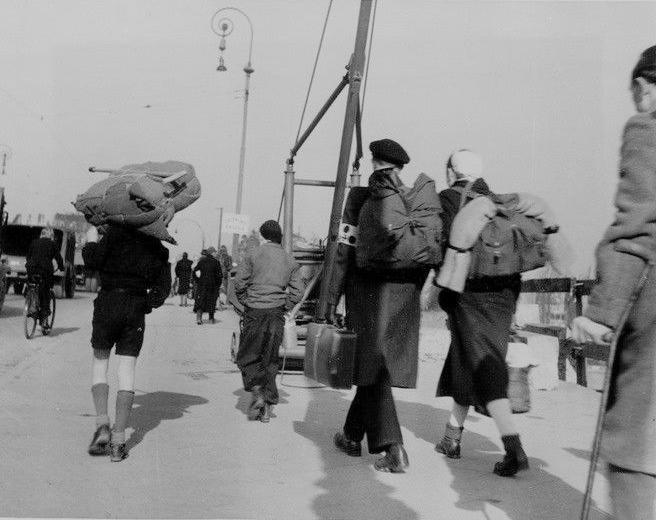
World War II Germany: Post War Transport Crises (1945-48)

Figure 1.--This photograph from Frankfurt shows people on the move, it was dated March 16, 1946. The caption read, "No Playtime: Children in post-war Germany: have no ime for the comedy of childhood. They are pressed into service vasccarriers when nothing on wheels is available." Notice the injured soldier at the right. Most German POS were still in POW camps, but injured soldiers ere often released.
|
|
Post-War Germany was awash with humnity. People liberated from German cincentration nd labor camps were trying to get home. Germans at war time assignments were trying to get home. German children evacuated to the country side were trying to get home.Germans in eastern Europe had fled the Red Army. Now those who were being expelled by the national governmnts. Ironically, many of the Jews who survivd the Holocaust were stuck in Germny. Jews from East Europe for the most part could not return home and the British blocked entry to Palestine. Western POWs got transport home. This was more difficult for Soviet POWs. Wounded German POWs were released. All of this movement except for the estern POWs was for the most part on foot. Virtually nothing on wheels except for Allied and Soviet military vehicles moved. The German transportation system was a major target of the Allied strategic bombing campaign, a key part of the effort to destoy the German war economy. And they did just that. Anything that moved in the Reich, trains, barges, trucks, anything on wheels was destroyed. Germans to move anywhere had to do so on their feet. One observer writes, "When Adolf Hitler set out to put Germany back on its feet, he did an excellent job, ably assisted by the British and American air forces." A few streetcars began moving in the cities, but they did not begin to meet thev needs. They almost ineviavlt were full with riders haghing on to the sides.
Nor was fuel available to power anything that was not destoyed. Only animal carts moved, but they were rare because so many horses had been destroyed in the War.
One observer writes, "In the cities one seas all kinds of wheeled contraptions pressed into service for hauling goods hither and yon. Bicycles pushcarts, an occasional horse and wagon, Even velocipedes -- are to be seen. in addition to wierd and wonderful gadgets for ligtening a load."
The German transport system would have to be rebuilt from the ground up. In the meantime the economy could not fumction. It was difficult to get foof an fuel (coal) into the cities. Without transport, there could be no manufcturing. Factories that survivd the bombing were left idle. The strategic bombing campaign was designed to destroy the NAZI war econmy. But after the War, it meant that the post-War economy was not functining.
CIH -- WW II

Navigate the CIH World WarII Section:
[Return to Main Western occupation zones page]
[Return to Main World War II German occupation page]
[Return to Main World War II German aftermath page]
[Return to Main Cold War page]
[Biographies]
[Campaigns]
[Children]
[Countries]
[Deciding factors]
[Diplomacy]
[Geo-political crisis]
[Economics]
[Home front]
[Intelligence]
[Resistance]
[Race]
[Refugees]
[Technology]
[Bibliographies]
[Contributions]
[FAQs]
[Images]
[Links]
[Registration]
[Tools]
[Return to the Main World War II page]
Created: 12:26 PM 7/22/2018
Last updated: 12:26 PM 7/22/2018



